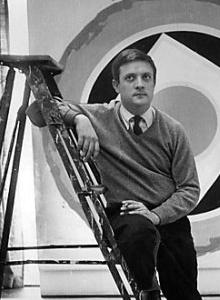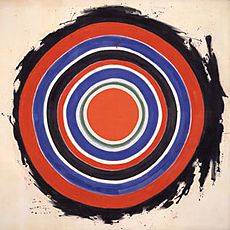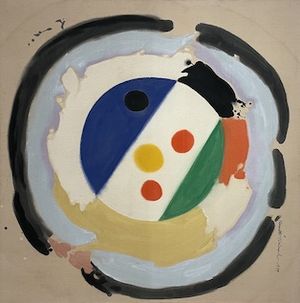Kenneth Noland facts for kids
Quick facts for kids
Kenneth Noland
|
|
|---|---|
 |
|
| Born | April 10, 1924 |
| Died | January 5, 2010 (aged 85) Port Clyde, Maine, U.S.
|
| Education | Black Mountain College |
| Known for | Abstract art |
| Movement | color field painting |
Kenneth Noland (born April 10, 1924 – died January 5, 2010) was a famous American painter. He was best known for his unique style called color field painting. This type of art uses large areas of flat color.
In the 1950s, people thought of him as an abstract expressionist. Later, in the early 1960s, he was seen as a minimalist painter. Noland helped start the Washington Color School movement. His art was shown in big exhibitions, including one at the Solomon R. Guggenheim Museum in New York in 1977.
Contents
- Kenneth Noland's Early Life and Art Education
- Kenneth Noland's Painting Career
- Kenneth Noland's Painting Technique
- Kenneth Noland's Personal Life
- Kenneth Noland's Death
- Kenneth Noland's Exhibitions
- Kenneth Noland's Influence
- Selected Museum Collections of Kenneth Noland's Art
- Selected Works by Kenneth Noland
- See also
Kenneth Noland's Early Life and Art Education
Kenneth Clifton Noland was born in Asheville, North Carolina. His father, Harry Caswell Noland, was a doctor who studied diseases. Kenneth had four brothers.
After finishing high school in 1942, Noland joined the U.S. Air Force. He fought in World War II. When the war ended, he used a special program called the G.I. Bill to study art. He went to the Black Mountain College in North Carolina. This college was known for its experimental and new ways of teaching art.
At Black Mountain College, Noland learned from important artists.
- Ilya Bolotowsky taught him about neoplasticism, a style of art that uses simple shapes and colors. He also learned about the work of Piet Mondrian.
- Josef Albers taught him about Bauhaus theory, which focused on how art and design could be useful. Noland also became very interested in how Paul Klee used color in his paintings.
Kenneth Noland's Painting Career

In 1948 and 1949, Noland worked with artist Ossip Zadkine in Paris, France. He had his first art show there in 1949. After returning to the U.S., he taught art in Washington, D.C., at Catholic University and the Institute of Contemporary Arts.
In the early 1950s, he met another artist named Morris Louis in Washington, D.C. They became good friends. In 1953, they visited Helen Frankenthaler's studio in New York City. They saw her new paintings and were very impressed. She used a special way of painting called the "soak-stain" technique. This meant she thinned her paints and let them soak right into the canvas. Noland and Louis started using this technique too.

Most of Noland's paintings can be put into four main groups:
- Circles (or targets): These paintings looked like bullseyes. He used interesting color combinations, like in his 1958 painting Beginning.
- Chevrons: These are V-shaped patterns.
- Stripes: Paintings made with many lines of color.
- Shaped canvases: These are canvases that are not the usual rectangle or square.
In 1964, Noland's work was part of an important art show called Post-Painterly Abstraction. This show helped make color field painting a very important art movement in the 1960s. Noland was a leader in using shaped canvases. For example, he made paintings on canvases shaped like diamonds or chevrons. In these works, the edges of the canvas became just as important as the painting in the middle.
During the 1970s and 1980s, his shaped canvases became even more unusual. They had complex shapes and very carefully chosen colors.
Kenneth Noland's Painting Technique
Kenneth Noland had a unique way of painting. Instead of using a brush to paint on the canvas, he would stain the canvas with color. This meant the paint soaked into the fabric. He wanted to remove the artist's hand from the painting. This way, the art piece itself became the most important thing, not how the artist applied the paint.
Noland also often left parts of the canvas bare, without any paint. This created a strong contrast with the colored areas. He used simple, abstract designs so that the design would not take away from the colors he used.
Kenneth Noland's Personal Life
Kenneth Noland was married four times. He had children with his first and third wives. His daughter, Cady Noland, also became a well-known artist.
Kenneth Noland's Death
Kenneth Noland passed away from kidney cancer at his home in Port Clyde, Maine, on January 5, 2010. He was 85 years old.
Kenneth Noland's Exhibitions
Noland had his first solo art show in Paris in 1948. In 1957, he had his first solo show in New York City. His art was shown in many important places around the world. In 1964, he had a large display at the Venice Biennale, a very famous art event.
After his death, the Solomon R. Guggenheim Museum honored him with a special show called Kenneth Noland, 1924–2010: A Tribute. His work has also been shown in museums like the Tate Liverpool in England and the Museum of Fine Arts, Houston.
Kenneth Noland's Influence
Kenneth Noland's art had an impact beyond just painting. In 1984, a clothing designer named Alexander Julian used Noland's designs and color ideas in his knitwear.
Selected Museum Collections of Kenneth Noland's Art
Many museums around the world have Kenneth Noland's paintings in their collections. Some of these include:
- Albright-Knox Art Gallery, Buffalo, New York
- Art Institute of Chicago, Chicago, Illinois
- Australian National Gallery, Canberra
- Baltimore Museum of Art, Baltimore, Maryland
- Butler Institute of American Art, Youngstown, Ohio
- Cleveland Museum of Art, Cleveland, Ohio
- Hirshhorn Museum and Sculpture Garden, Washington, D.C.
- Metropolitan Museum of Art, New York
- Museum of Modern Art, New York
- National Gallery of Art, Washington, D.C.
- Solomon R. Guggenheim Museum, New York
- Tate Gallery, London
- Whitney Museum of American Art, New York
Selected Works by Kenneth Noland
Here are some of Kenneth Noland's famous paintings:
- (1958) Beginning
- (1958) Ex-Nihilio
- (1958) Lunar Episode
- (1959) The Clown
- (1960) Back and Front
- (1961) Highlights
- (1963) Ringing Bell
- (1963) Thrust
- (1964) Baba Yagga
- (1964) Tropical Zone
- (1965) Stack
- (1966) Galore
- (1967) Summer Plain
- (1967) Stria
- (1973) Interlocking Color
- (1975) Burnt Beige
- (1978) Oasis
- (1985) Snow and Ice
- (1989) Doors: Time Ahead
- (1999) Refresh
- (2000) Mysteries: Infanta
See also
 In Spanish: Kenneth Noland para niños
In Spanish: Kenneth Noland para niños

